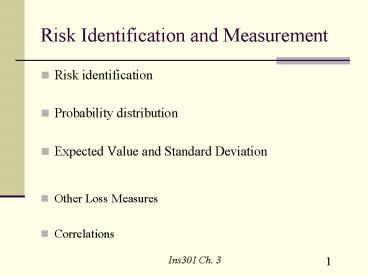Risk Identification and Measurement - PowerPoint PPT Presentation
1 / 27
Title:
Risk Identification and Measurement
Description:
A probability distribution identifies all the possible outcomes for ... Important characteristic of density functions. Area under the entire curve equals one ... – PowerPoint PPT presentation
Number of Views:1045
Avg rating:5.0/5.0
Title: Risk Identification and Measurement
1
Risk Identification and Measurement
- Risk identification
- Probability distribution
- Expected Value and Standard Deviation
- Other Loss Measures
- Correlations
2
Identifying Business Risk Exposures
- Property
- Business income
- Liability
- Human resource
- External economic forces
3
Identifying Business Exposures
- Property
- Business income
- Liability
- Human resource
- External economic forces
4
Identifying Individual Exposures
- Earnings
- Physical assets
- Financial assets
- Medical expenses
- Longevity
- Liability
5
Probability Distribution
- A probability distribution identifies all the
possible outcomes for the random variable and the
probability of the outcomes
6
Probability Distribution Example1
- Random variable damage from auto accidents
- Possible Outcomes for Damages Probability
- 0 0.50
- 200 0.30
- 1,000 0.10
- 5,000 0.06
- 10,000 0.04
7
Graph of Example1
8
Probability Distribution Example2
- Find the probability that the loss gt 5,000
- Find the probability that the loss lt 2,000
- Find the probability that 2,000 lt loss lt 5,000
Probability
Possible Losses
5,000
2,000
9
Continuous Distribution
- Important characteristic of density functions
- Area under the entire curve equals one
- Area under the curve between two points gives the
probability of outcomes falling within that given
range
10
Risk Management Probability Distributions
- Ideally, a risk manager would know the
probability distribution of losses - Then assess how different risk management
approaches would change the probability
distribution
11
Which distribution would you rather have?
Prob
Cost
Cost
12
Frequency of Loss and Severity of Loss
- Frequency of loss measures the number of losses
in a given period of time - Severity of loss measures the magnitude of loss
per occurrence
13
Expected Loss
- When the frequency and severity of losses is
uncorrelated with each other, then - Expected Loss Frequency Severity
14
Example
- 50,000 employees in each of the past five years
- 1,500 injuries over the five-year period
- 3 million in total injury costs
- Frequency of injury per year 1500 / 50000
0.03 - Average severity of injury 3 m/ 1500 2,000
- Annual expected loss per employee 0.03 x 2,000
60
15
Expected Value
- Formula for a discrete distribution
- Expected Value x1 p1 x2 p2 xM pM .
- Example
- Possible Outcomes for Damages Probability
- 0 0.50
- 200 0.30
- 1,000 0.10
- 5,000 0.06
- 10,000 0.04
- Expected Value
16
Variance and Standard Deviation
- Variance measures the probable variation in
outcomes around the expected value - Standard deviation is the square root of the
variance - Standard deviation (variance) is higher when
- when the outcomes have a greater deviation from
the expected value - probabilities of the extreme outcomes increase
17
Variance and Standard Deviation
- Comparing standard deviation for three discrete
distributions - Distribution 1 Distribution 2 Distribution 3
- Outcome Prob Outcome Prob Outcome Prob
- 250 0.33 0 0.33 0 0.4
- 500 0.34 500 0.34 500 0.2
- 750 0.33 1000 0.33 1000 0.4
18
Standard Deviation and Variance
19
Sample Mean and Standard Deviation
- Sample mean and standard deviation can and
usually will differ from population expected
value and standard deviation - Coin flipping example
- 1 if heads
- X
- -1 if tails
- Expected average gain from game 0
- Actual average gain from playing the game 5 times
20
Skewness
- Skewness measures the symmetry of the
distribution - No skewness gt symmetric
- Most loss distributions exhibit skewness
21
Maximum Probable Loss
- Maximum Probable Loss at the 95 level is the
number, MPL, that satisfies the equation - Probability (Loss lt MPL) lt 0.95
- Losses will be less than MPL 95 percent of the
time
22
Value at Risk (VAR)
- VAR is essentially the same concept as maximum
probable loss, except it is usually applied to
the value of a portfolio - If the Value at Risk at the 5 level for the next
week equals 20 million, then - Prob(change in portfolio value lt -20 million)
0.05 - In words, there is 5 chance that the portfolio
will lose more 20 million over the next week
23
Value at Risk
- Example
- Assume VAR at the 5 level 5 million
- And VAR at the 1 level 7 million
24
Important Properties of the Normal Distribution
- Often analysts use the following properties of
the normal distribution to calculate VAR - Assume X is normally distributed with mean ? and
standard deviation ?. Then - Prob (X gt ? 2.33?) 0.01
- Prob (X lt ? -2.33?) 0.01
- Prob (X gt ? 1.645?) 0.05
- Prob (X lt ? -1.645?) 0.05
25
Example
- Company A estimates the expected value and
standard deviation of its total property loss as
20 million and 5 million. Assume the total
property loss is normally distributed, what is
the predicted maximum probable loss at the 95
percent level? at the 99 percent level?
26
Correlation
- Correlation identifies the relationship between
two probability distributions - Uncorrelated (Independent)
- Positively Correlated
- Negatively Correlated
27
Exercise Expected value and standard deviation
- Outcome probability
- 250 0.05
- 300 0.25
- 400 0.55
- 500 0.15
- Calculate the mean and standard deviation of the
loss distribution.































